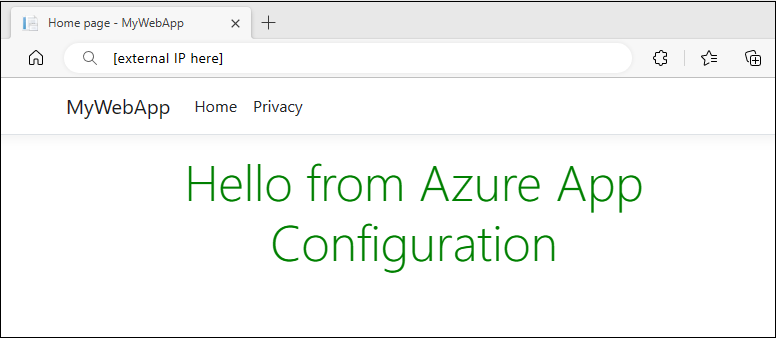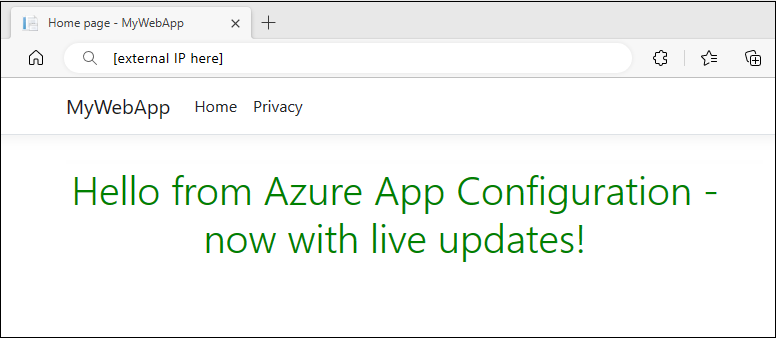Note
Access to this page requires authorization. You can try signing in or changing directories.
Access to this page requires authorization. You can try changing directories.
If you use Azure Kubernetes Service (AKS), this tutorial shows you how to enable dynamic configuration for your workloads in AKS by leveraging Azure App Configuration and its Kubernetes Provider. The tutorial assumes that you work through the quickstart and have an App Configuration Kubernetes Provider set up, so before proceeding, make sure you complete the Use Azure App Configuration in Azure Kubernetes Service quickstart.
Tip
See options for workloads hosted in Kubernetes to access Azure App Configuration.
Prerequisites
Finish the quickstart: Use Azure App Configuration in Azure Kubernetes Service.
Reload data from App Configuration
Open the appConfigurationProvider.yaml file located in the Deployment directory. Then, add the
refreshsection under theconfigurationproperty. It enables configuration refresh by monitoring the sentinel key.apiVersion: azconfig.io/v1 kind: AzureAppConfigurationProvider metadata: name: appconfigurationprovider-sample spec: endpoint: <your-app-configuration-store-endpoint> target: configMapName: configmap-created-by-appconfig-provider configMapData: type: json key: mysettings.json auth: workloadIdentity: managedIdentityClientId: <your-managed-identity-client-id> configuration: refresh: enabled: trueTip
You can set the
intervalproperty of therefreshto specify the minimum time between configuration refreshes. In this example, you use the default value of 30 seconds. Adjust to a higher value if you need to reduce the number of requests made to your App Configuration store.Open the deployment.yaml file in the Deployment directory and add the following content to the
spec.containerssection. Your application loads configuration from a volume-mounted file the App Configuration Kubernetes provider generates. By setting this environment variable, your application can use polling to monitor changes in mounted files.env: - name: DOTNET_USE_POLLING_FILE_WATCHER value: "true"Run the following command to deploy the change. Replace the namespace if you're using your existing AKS application.
kubectl apply -f ./Deployment -n appconfig-demoOpen a browser window, and navigate to the IP address obtained in the previous step. The web page looks like this:

Update the following key-values in your App Configuration store.
Key Value Settings:Message Hello from Azure App Configuration - now with live updates! After refreshing the browser a few times, you'll see the updated content once the ConfigMap is updated in 30 seconds.

Reload ConfigMap and Secret
App Configuration Kubernetes provider generates ConfigMaps or Secrets that can be used as environment variables or volume-mounted files. This tutorial demonstrated how to load configuration from a JSON file using the .NET JSON configuration provider, which automatically reloads the configuration whenever a change is detected in the mounted file. As a result, your application gets the updated configuration automatically whenever the App Configuration Kubernetes provider updates the ConfigMap.
If your application is dependent on environment variables for configuration, it may require a restart to pick up any updated values. In Kubernetes, the application restart can be orchestrated using rolling updates on the corresponding pods or containers. To automate configuration updates, you may leverage third-party tools like stakater/Reloader, which can automatically trigger rolling updates upon any changes made to ConfigMaps or Secrets.
Next steps
To learn more about the Azure App Configuration Kubernetes Provider, see Azure App Configuration Kubernetes Provider reference.